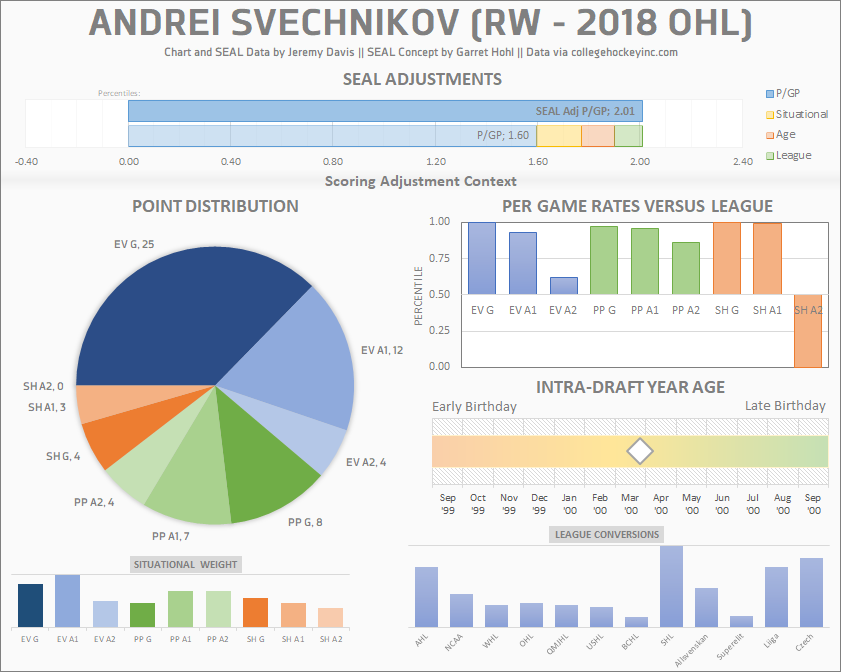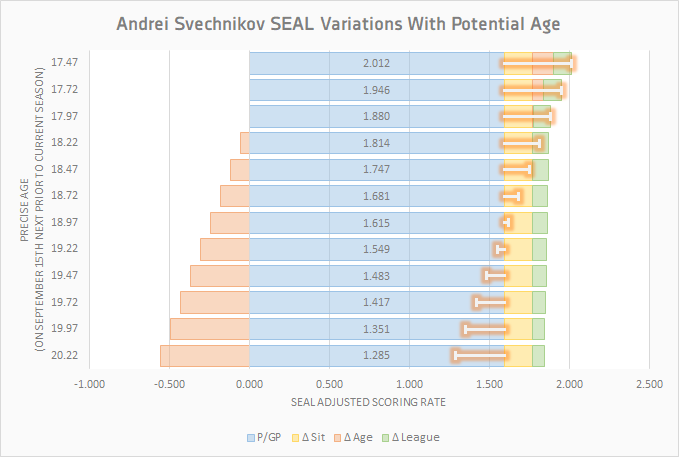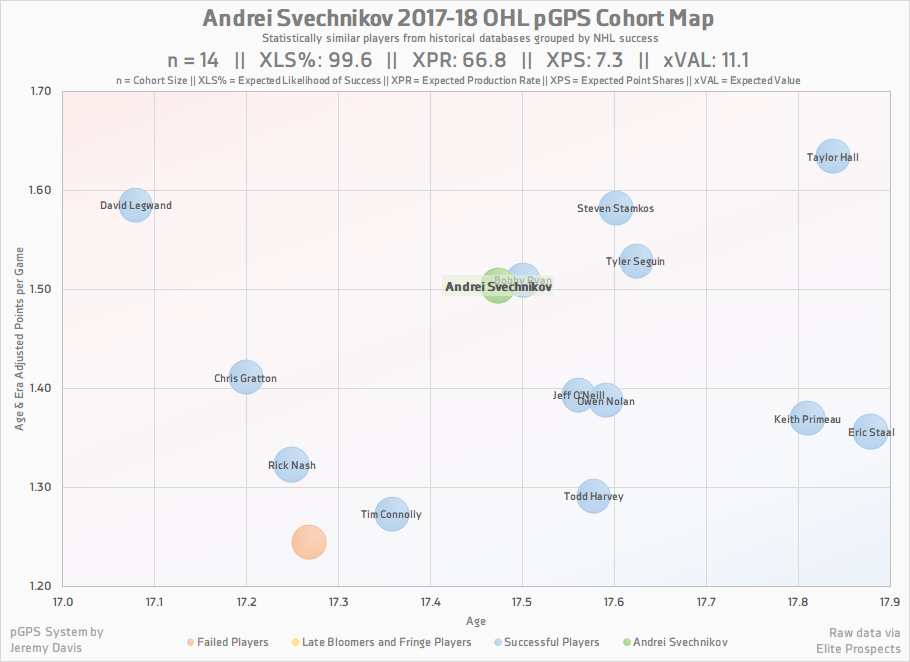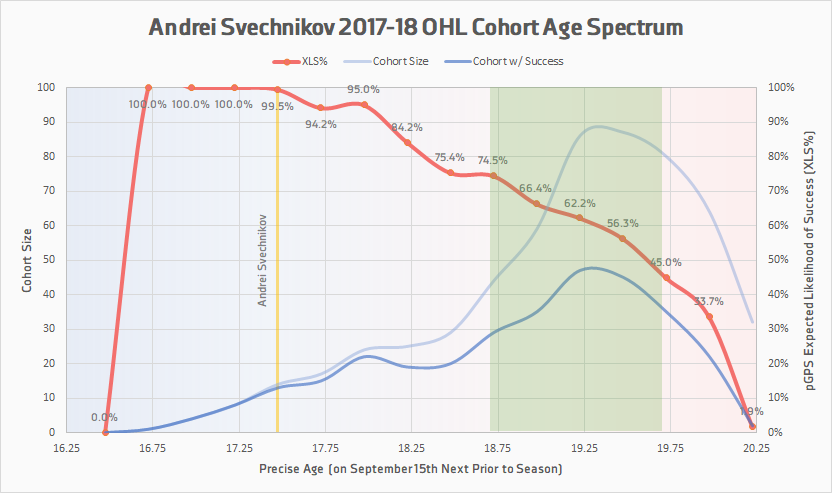Andrei Svechnikov and the Pivotal Importance of Precise Age

By Jeremy Davis
6 years agoThe 2017-18 season is winding down, and with playoff games on the horizon, we’ve got nearly a full season sample with which to assess this year’s crop of draft prospects. Trends have emerged, some players have separated themselves, while others are falling into the pack. One player that stands alone is Rasmus Dahlin, and unless your hot take machine is on overdrive, he should be a clear number one in your rankings.
After that however, things aren’t as clear as they appeared earlier in the season. The second overall spot once seemed reserved for Russian power winger Andrei Svechnikov, but a couple of developments have leveled the playing field a little, opening up the number two spot for some good old competition.
The 2018 World Junior Hockey Championship certainly has a role in this story, and Svechnikov’s chief forward competitors – Filip Zadina and Brady Tkachuk – were among the most impressive players in that tournament. Tkachuk compiled nine points (three goals, six assists) in seven games, while Zadina scored seven times in seven contests while adding an assist. Svechnikov was held goalless in five games, but did pick up five assists, while playing a noticeably smaller role with Russia that Tkachuk and Zadina did with their respective clubs. Svechnikov averaged just 11:07 per game in ice time, dwarfed by Tkachuk’s 19:36 and Zadina’s 20:27.
If we look at their domestic campaigns from a statistical perspective, the order shakes out like this: Svechnikov, Zadina, Tkachuk. That’s the rank order provided by both the pGPS cohort model and the SEAL adjusted scoring model. It’s close, but Svechnikov remains on top.
Moving away from just pure production measures, Svechnikov reigns supreme in on-ice measures as well, besting his competitors in both 5-on-5 goals-for percentage (GF%) and relative goals-for percentage (GF%rel). He provides a greater net value to his team in terms of goal differential than almost any other draft eligible player.
All that is marvellously impressive, and I’d be inclined to declare him the winner of this race for second best. However, because Svechnikov plays in a junior league, all expectations need to be reconciled based on his exact age, and unfortunately, there’s a bit of an issue there: there are rumors starting to float around that Svechnikov may be older than his file claims him to be.
Just to be up front on this, I want to clarify that I don’t know for certain if this is the case. I’ve been told that his birth date could actually been in 1998 (which would make him somewhere between 15 and 27 months older than he was thought to be), but I am in no position to be able to confirm this. So what follows here will simply be an exploration of what that difference in age would mean when analyzing his statistical output. If you are in a position to verify his age, and he does turn out to be older than he’s supposed to be, you’d do well to consider the implications of that, as laid out below.
Before we get to that, let’s review a cautionary tale of a player who was in a similar situation.
Grigorenko: A Cautionary Tale
You may recall similar age-related rumors with Mikhail Grigorenko back in 2012. Once considered a sure-fire star, Grigorenko’s stock began to fall during his draft year when rumors began to circulate that he was a couple of years older than he was supposed to be.
At least partially as a result of these rumors, Grigorenko, who tore apart the QMJHL that year collecting 85 points in 59 games, fell all the way to 12th, where he was taken by the poor Buffalo Sabres. Now, by all published accounts, that rumor was apparently false. According to Andrey Osadchenko of MapleLeafsNation at the time, the FSB – successors to the KGB, who you may have heard of – looked into the situation and found nothing suspicious.
You can choose to believe that account if you wish, but given Russia’s penchant for corruption – which has only gotten worse since then – it’s awfully difficult to give anyone involved in that situation the benefit of the doubt.
Another thing that’s gotten worse since 2012: Grigorenko’s career path. Since those stories about how Grigorenko’s age definitely wasn’t faked were written shortly before he was drafted, Grigorenko has done little more than struggle. He struggled to make the NHL, he struggled to stay in the NHL, and he struggled to produce there. Finally, just this season, he returned to mother Russia to join CSKA Moscow, after totaling just 64 points in 217 career NHL games split between Buffalo and the Colorado Avalanche.
There are a myriad of potential explanations for why Grigorenko failed to become an impact player in the NHL. The teams he played for (Buffalo and Colorado) were outrageously bad, so he wasn’t exactly given a lot of help. The Sabres tried to shoehorn him into their lineup in both his draft-plus-one and draft-plus-two seasons, but both times he ended up back in junior. In his draft-plus-three season, he was again given a chance to stick on the big club roster, but spend the majority of that season in the American League instead. Additionally, reported issues with his work ethic and intensity level could easily have hampered his ability to succeed even if he was the age he was supposed to be.
It’s hard to ignore that in those three seasons, Buffalo finished 23rd, 30th and 30th (the years that netted them Rasmus Ristolainen, Sam Reinhart, and Jack Eichel), and he did improve when he was traded to Colorado prior to the start of the next season (he averaged 25 points over two seasons there), but it’s also hard to ignore that Grigorenko’s career trajectory looked an awful lot more like a guy who was 20 was he was drafted than a guy who was 18.
While we may never definitely know that truth about Grigorenko, the fact that similar rumors are now emerging around Svechnikov should, at the very least, make one stop and consider the implications of a false age, even if you aren’t inclined to believe that the rumors are true. As one person put it to me, by the time the draft rolls around, most teams will be aware whether or not he is older than he seems, but many won’t be aware of what that really means. So let’s take a journey through the numbers and see what those implications might be.
What a Difference a Year (or Two) Makes
Age adjustments have been a big part of what we do here at Canucks Army for quite some time. Former managing editor Rhys Jessop’s work prior to the 2014 draft introduced a lot of extremely important fundamental concepts that laid the groundwork for PCS (and subsequently pGPS), and age adjusting the production of draft eligible prospects was a part of that.
Since then, age adjustments have been incorporated into both pGPS and SEAL (the ‘A’ stands for Age, as you may know), so I’ve become extremely familiar with the formulas myself. One thing that you’ll notice if you look at an array of age adjustment coefficient for various leagues is that they have quite a wide range. Junior leagues, capped at 20 or 21 years of age, tend to have large age adjustment coefficients, while professional leagues, with no age caps, have much smaller coefficients.
Age Adjustment Coefficients for Forwards in Prominent NHL Feeder Leagues
| WHL | OHL | QMJHL | USHL | NCAA | AHL | SHL | Liiga | Russia | Czech | Allsvenskan | Superelit |
| 0.149 | 0.141 | 0.159 | 0.107 | 0.066 | 0.027 | 0.052 | 0.037 | 0.037 | 0.050 | 0.063 | 0.140 |
The reason for this, in my opinion, is the age ranges of the leagues. In the junior leagues, specifically the CHL, where there is an age range of only about five years, growth and development play a massive role. The different in physical and mental maturity between a 16 and a 19 is enormous, and their point rates are often reflective of that. The coefficients above are drawn from a pool of players that played at least three seasons in a given league (to reduce the effect of mortality) between 1990 and 2016. In the CHL leagues, players can expect to gain a point per game boost between 0.14 and 0.16 for each year of development. That’s a huge amount, and it can seriously affect the statistical projection of a player if the age is changed even by a year or two.
Since he’s the topic of our discussion, let’s take a look at Svechnikov here. First, let’s look at how his SEAL adjusted scoring rate (which, again, takes into account exact age), and how it changes as months are added to his age.
First of all, Svechnikov’s situational production seems built for SEAL – he thrives in all the right areas, and the areas in which is isn’t among the league’s best (such 5-on-5 secondary assists) are areas that he can get away with having lower rates in.

Svechnikov, as it stands, gets a small bump from age adjustments, as the system adjusts his production as if he were exactly 18 years old at the cut off date (September 15th prior to the start of the season). Naturally, once you start adding months to his age, that age adjustment bonus disappears and quickly becomes a deficit. The following chart shows the different SEAL adjustments at a variety of precise ages, starting at his reported age (17.47) and increasing in increments of three months as you proceed down the chart. The data labels in the middle represent his SEAL adjusted rate, while the error bars (in white with a red glow) denote the change from raw points per game to SEAL adjusted points per game.

Next we’ll perform the same exercise with pGPS. First, if we assume that his reported age is correct, Svechnikov looks like a pGPS stud. His 99.6% is the highest expected likelihood of success of anyone available in the draft (though Rasmus Dahlin simply doesn’t have any comparables since he’s scoring at an unprecedented rate for a teenaged defenceman in the SHL). Svenchnikov’s comparables currently include the likes of Steven Stamkos, Tyler Seguin, Taylor Hall, Rick Nash, and Eric Staal – clearly we’re dealing with some elite offensive talent here.

But what if we increase his age a little bit?
Similar to what I did with Cole Cassels, where I ran pGPS numbers based on a spectrum of production at his precise age, I put together this spectrum chart below for Svechnikov based on his exact production with varying ages. The yellow line signifies his reported age, with his 99.6% expected likelihood of success percentage. The green area indicates the range of ages possible if we operate under assumption that the 1998 birth year rumor has truth to it. You can see how precipitously his XLS% drops as his potential age increases.

It’s also notable that even as he increases towards age-20, his likelihood of success is still very high. The conclusion to draw from that is that even if Svechnikov is 18 to 24 months older than he’s supposed to be, he’s still a very promising prospect. As it stands, Svechnikov ranks second in SEAL adjusted scoring (to Dahlin) and first in pGPS expected value (with Dahlin essentially being off the charts). If we imagine an 18-month increase in exact age, giving him a September 26th, 1998 birthday and a precise age of 18.97, Svechnikov drops to sixth in pGPS expected value, and twelfth in SEAL adjusted scoring.
Conclusion
I’ll say this once more: I don’t have any conclusive evidence regarding Andrei Svechnikov’s age or birthday, so don’t bother asking. There will undoubtedly be people that scoff at these rumors, and call them ridiculous, much as many did with Grigorenko in 2012. I’m not here trying to convince anyone that he needs to drop because he’s too old. What I am trying to do is demonstrate the paramount importance of precise age when it comes to prospects in junior leagues. If you happen to be in a position to definitely determine that Svechnikov is in fact older than he was thought to be, I urge you to at least consider what I’ve written here. Understand the effect that that extra bit of growth and development have on a player who is dominating teenagers.
Because this situation remains murky, I’m in a tough position with regards to how to rank Svechnikov at this point. If the rumors are completely false, he probably deserves to stay at second overall. However, if the rumors are true, he probably deserves to be in the five-to-seven region. At the top of the draft, a handful of spots is a pretty huge swing in potential value.
As a result of the uncertainty, he’s just going to have to go somewhere in between. Given how close Zadina is already, it’s a no-brainer to bump him up to second. I’m not sure I’d feel comfortable moving Tkachuk ahead of him at this juncture (I tend to think Tkachuk’s a bit overrated already to be honest), but I’d be inclined to move defenceman Quinn Hughes, who’s tearing up the NCAA and is clearly the second best defenceman in the draft (sorry Adam Boqvist), ahead of the big Russian winger. I think for now, fourth is as low as I’d go with Svechnikov. If we can get any definitive confirmation before the draft rolls around, then we can rank these players with much more certainty. Until then, we’ll do the best we can with what we’ve got.
Recent articles from Jeremy Davis





